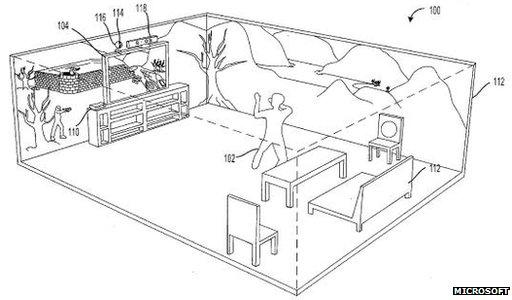Microsoft Xbox 3D-projected games outlined in patent
- Published

Microsoft envisages transforming the players' room into an immersive gaming environment
Details of an immersive video games display system that projects images of the title's environment around a player's room have been revealed in a US patent belonging to Microsoft.
The Xbox maker describes extending graphics beyond the edges of a TV to "make the experience more realistic".
A spokesman said he could not comment about when a product might be released.
Sony appears to be pursuing a different strategy. A video from the firm hints at a new augmented-reality headset.
Both firms are expected to announce details of their next-generation consoles in 2013.
Their rival, Nintendo, will provide more detail about the release of its Wii U games machine at a New York event on Thursday.
Scan and project
Microsoft's patent, external suggests that current games console systems are constrained by their reliance on a single screen.
"Such displays are typically the only source of visual content, so that the media experience is bounded by the bezel of the display," it said.
"Even when focused on the display, the user may perceive architectural and decorative feature of the room the display is in... such features are typically out of context with respect to the displayed image, muting the entertainment potential."
The firm says the solution is to beam images all over the room so that the gamer's peripheral vision does not conflict with what they seen on the main screen.

The player's head could be tracked to ensure the projected images show the right perspective
It adds that the innovation could also offer new gaming experiences such as allowing to player to "turn around and observe an enemy sneaking up from behind".
To make this possible the company suggests the equipment would require a sensor to scan the layout of the room.
This would allow the console to make the images fit the environment. The patent describes how the beamed graphics could be altered to take account of a cylindrical lamp that might otherwise distort them, and to adjust for the colour of the walls.
It adds that a separate depth camera could also be utilised to adjust the perspective of the images displayed depending on the position of the user's head.
All this is likely to put an increased strain on any games machine's processor - a point the patent acknowledges when it suggests "the peripheral image may be displayed at a lower resolution than the primary image without adversely affecting user experience."
Virtual reality headset
A video posted by Sony , externalto its YouTube account, and spotted by the tech site VG247, external suggests the PlayStation maker is focusing on head-mounted display.

Sony says its headset would offer a "360 degree immersive entertainment sensation"
It shows a sleek metallic virtual reality headset featuring small screens inside the device and a camera extending from its outside, presumably to provide live images from the users' environment.
Accompanying text says the device is a head-tracking prototype that will be put on display at the Tokyo Game Show.
One industry watcher said it was not far-fetched to believe either product would eventually make it to market.
"Both of these ideas reflect a key competitive imperative: the firms have to keep their gaming experiences differentiated from everything else available on the market," Ed Barton, director of digital media at Strategy Analytics told the BBC.
"They are continually trying to offer something that makes their proprietary system as the 'best experience on the market' - in other words a reason for gamers to spend £500 on their box."
- Published1 August 2012
- Published29 June 2012
- Published5 June 2012
- Published9 May 2012